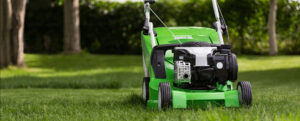 Turfgrass seeds require soil temperatures of at least 55 degrees and moisture to germinate. Once the germination process has started, it is irreversible and the soil must be kept moist. Always remember that DRY OUT = DIE OUT. Germination begins long before you see new seedlings emerging; in fact, the early part of lawn establishment before you see the little shoots emerging may be the most crucial time for watering. Not all seeds will sprout at the same time; germination times vary from 5 days to over 28 days. Different species (we seed a mixture of recommended species), soil temperatures and varying planting depths all play a role in speed of emergence, and just because you see some little shoots emerging, emergence is almost certainly far from complete. So you must be diligent in your watering if rainfall is at any time deficient.
Turfgrass seeds require soil temperatures of at least 55 degrees and moisture to germinate. Once the germination process has started, it is irreversible and the soil must be kept moist. Always remember that DRY OUT = DIE OUT. Germination begins long before you see new seedlings emerging; in fact, the early part of lawn establishment before you see the little shoots emerging may be the most crucial time for watering. Not all seeds will sprout at the same time; germination times vary from 5 days to over 28 days. Different species (we seed a mixture of recommended species), soil temperatures and varying planting depths all play a role in speed of emergence, and just because you see some little shoots emerging, emergence is almost certainly far from complete. So you must be diligent in your watering if rainfall is at any time deficient.
How much water?
The average person uses too little water, but of course it’s possible to overwater, also. Overwatering causes erosion and pooling and seed floating/seed washing (although some seed floating is unavoidable and will not cause harm). Lots of people spray the ground with a handheld trigger-type hose sprinkler for a few seconds and then move on. This is not nearly enough, as only the very top of the soil becomes moist. Enough water is needed to wet the soil profile at least a couple of inches deep. To avoid excessive pooling and runoff, this normally means light and slow watering so the water can soak in during application. Oscillating sprinklers work good in this regard as the water has a bit of time to soak in between passes. 30 minutes should be enough time for an oscillating sprinkler to remain in any one spot.
A good rule of thumb is to keep the soil moist enough that you can easily push a finger down into the soil 1.5” or so at some point every day for the first month after seeding, and most likely even longer for early-spring seeding dates that cause the new seedlings to emerge slower. Between waterings, the soil should be moist but not soggy/waterlogged. The best times to water during establishment are early in the morning and later in the afternoon or evening. Typically, there is less wind during these times and the water distribution is more even.
How often should I water?
The short answer is every day. In reality, on spring sowings, it depends on ambient temperatures, sunshine, and wind. This will vary to possibly only every other day in early spring when it’s normally rather cool (which slows the soil drying process), every day in the prime spring seeding season, and possibly twice a day later in the spring seeding season when it tends to be hotter and windier (wind dries the soil faster). Just keep the soil moist but not waterlogged.
I need to be gone for a while, what should I do?
You better have someone lined up to water for you in case there aren’t timely rains while you’re gone. Without a doubt, the #1 cause of seeding failures is ambivalence, long weekends, vacations, etc.
When can I stop watering?
That’s a hard call. Certainly not before the lawn has become well-established. Less frequent but heavier soakings work well once the lawn is nicely established, as the threat of seed floating, water pooling, and soil erosion is by then greatly reduced. Some judgement will have to be used—80 degrees, overcast, and a bit too dry is certainly nowhere near as bad as 95 degrees, sunny, windy, and in a drought. A good rule of thumb is, turfgrass needs 1” of water a week for the first year of its life, so keep that in mind as you watch the weather forecasts.
When should I begin to mow?
Begin mowing when the newly-seeded lawn is approximately 3.5-to 4” tall, and only remove 1/3 or less of the lawn’s overall height. If you wait longer before the first mowing, mow in stages to get to the desired height. Taking a lot off all at once will scalp the lawn, and kill the young plants.
When can I spray for weeds?
The lawn should be well-established enough to have been mowed at least 3 times before you even consider herbicide application. Herbicides shouldn’t be applied if the temperature has been, or will be either below 50 or above 85 degrees for either a few days before or for several days after application, or if the lawn is undergoing any stress. Personally, I don’t like to see any herbicide applications to spring-seeded lawns until after the first frost in the fall.
Remember that the most common reason for failure of newly-seeded lawns is inadequate watering.
Copyright Dave Pepper 2017


